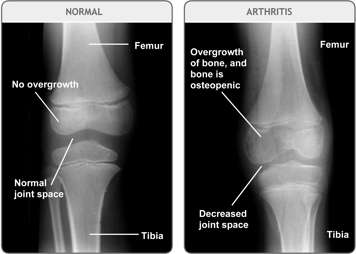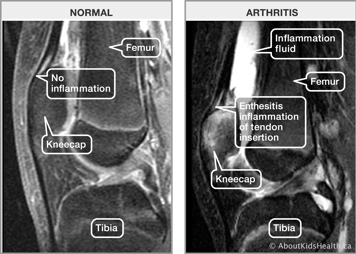In addition to blood tests, you may need to have several imaging tests to help the doctors see your bones and joints and make a better diagnosis. These imaging tests include X-rays, an MRI, ultrasound, bone scan, and bone density test.
X-rays
An X-ray is a type of radiation that passes through the body. An X-ray leaves a shadow of one’s bones on a photograph. It gives the doctor information on the size, shape, and location of the bones and certain organs. This information can help diagnose a condition. It is also called radiography. The amount of radiation in an individual X-ray is small and not believed to be a health risk.
Below is an X-ray of a normal knee joint versus an arthritic knee joint. The knee on the right shows the effects of arthritis. Inflammation and increased blood flow to the joint causes bone overgrowth, decreased joint space and decreased bone density (bone appears not as white in an X-ray, which means that it is less dense. This is called osteopenia).

Why are X-rays done?
When a patient first develops arthritis, X-ray results may be normal, although in some cases narrowing of the joints can already be seen and can help with diagnosis. X-rays are often used to exclude other problems, like cancer or infection. They can also be used to make sure JIA has not caused early damage to your bones.
How are X-rays done?
You may first need to change into a hospital gown. Then you will be asked to stand next to the X-ray film. The X-ray machine will be turned on for a few seconds. During the X-ray, invisible beams of radiation will pass through your body to make a picture on the film. You will need to hold still for two or three seconds so the picture does not blur.
Usually, an X-ray is taken from the front and then the side. You will not feel anything. Also, because very little radiation is released through the X-ray, it will not cause damage to your body. However, health care providers will try to limit doing multiple X-rays over time in order to limit radiation exposure.
Magnetic resonance imaging (MRI)
Magnetic resonance imaging (MRI) is another type of imaging test. The MRI machine uses a magnet, radio signals, and a computer to scan and produce images of the body. Each image shows a different “slice” or level of the body. A special type of doctor, a radiologist, reads the images or scans. An MRI scan is fairly noisy but does not hurt. If you are able to lie still for an hour then usually no medication will be given. If, however, you have trouble lying still for that time, perhaps because your joints are hurting, a medicine can be given to help you relax or sleep. This medicine is given either by mouth or through an IV.

How is an MRI done?
Before starting the MRI, you will change into a hospital gown. Then you will lie on a hard bed in front of the MRI machine.
The MRI scanner is a large square machine with a deep, wide tunnel in the center. When everything is ready, including any needed sedation, your bed will be moved into the tunnel. All of your body will be inside the tunnel. The MRI scanner makes a loud knocking or drumming sound during scanning. However, you will be able to speak with the radiologist through a speaker.
Some people find being inside the tunnel of the MRI scary. The MRI can be stopped if this is too difficult for you, although then only part of the desired information will be available to your doctors.
MRI scans give the doctor more information when they are done with a special fluid called contrast. If this is necessary, the contrast will be given to you through an intravenous (IV) tube placed in your vein.
Unless you are receiving a general anesthetic (special medication to make you sleep) for the scan, a family member may be able to stay with you in the room throughout your MRI. There might also be a nurse and anesthetist in the room with you.
Once you are done, the radiologist will review the MRI. The radiologist will send a report to your doctor to be reviewed. Your doctor will discuss the results of the study with you at a follow-up appointment.
Ultrasound
Ultrasound is another type of imaging. The ultrasound machine uses high-frequency sound waves to produce pictures of internal organs and other structures in your body. For example, they can look for fluid in hip joints or tendons. Ultrasounds can also be used by your doctor to determine where to insert the needle for a joint injection if you are having one done. The ultrasound may be done by a radiologist, a radiology nurse or your pediatric rheumatologist.
How is an ultrasound done?
Before starting the ultrasound, you may change into a hospital gown. Then you will be asked to lie on a bed beside the ultrasound machine.
A special type of gel is put on your skin over the joint that is being studied. The person performing the ultrasound will move a special probe called a transducer back and forth over your skin. The ultrasound probe does not hurt, although you might feel pressure.
The scan usually takes about 15 minutes.
Once you are done, the doctor will review the ultrasound. Your doctor will discuss the results of the study with you at a follow-up appointment.